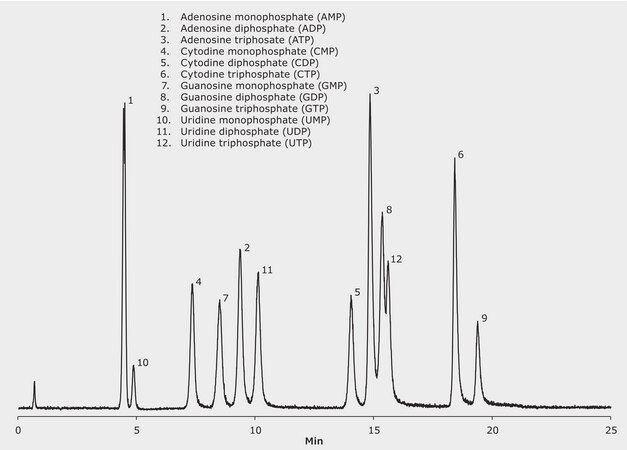LC/MS Analysis of Nucleotides on SeQuant® ZIC-cHILIC

Materiales
standard
CONDITIONS
column
SeQuant® ZIC-cHILIC, 10 cm x 2.1 mm, 3.0 μm particles (1.50657)
mobile phase
[A] acetonitrile; [B] 50 mM ammonium acetate, pH 5.0 with acetic acid in water
gradient
26 to 27% B in 10 min; to 27 to 35% B in 10 min; to 26% B in 0.1 min; hold at 26% B for 9.9 min
flow rate
0.3 mL/min
pressure
1029 psi (71 bar)
column temp.
50 °C
detector
Q-TOF (ESI-negative), XIC of the following m/z values: AMP-346, ADP-426, ATP-506, CMP-322, CDP-402, (CTP-482, GMP-362, GDP-442, GTP-522, UMP-323, UDP-403, UTP-483)
injection
10 μL
sample
10-30 μg/mL of nucleotides (AMP, ADP, ATP, CMP, CDP, CTP, GMP, GDP, GTP, UMP, UDP, UTP) (80/20 acetonitrile/50 mM ammonium acetate in water, pH 5.3 with acetic acid)
Descripción
Analysis Note
Nucleotides are the building blocks of nucleic acids. They comprise a nitrogenous base, a sugar, and a phosphate group making them highly polar and ionic. This causes a challenge for typical reversed phase chromatography (RPC). These charged polar analytes are poorly retained by RPC, and thus typically chromatographed by either ion-exchange chromatography or RPC in conjunction with an ion-pairing reagent. Nucleotide analysis using ion-pair reagents or high concentration of phosphate buffers cause high background and ion source pollution for MS detection. HILIC separation is an alternative that permits sensitive MS detection and without the use of ion-pair reagents.
Legal Information
SeQuant is a registered trademark of Merck KGaA, Darmstadt, Germany